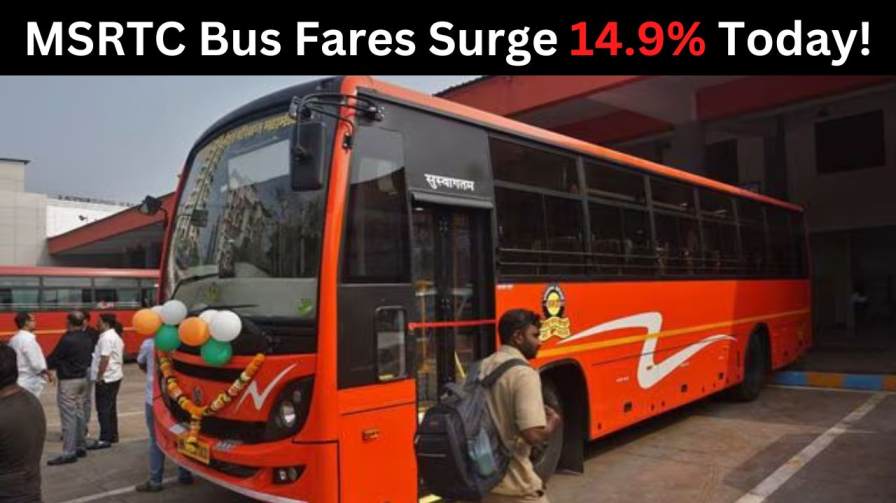Mumbai’s daily commuters are facing a significant rise in their transportation costs today, as the Maharashtra State Road Transport Corporation (MSRTC) implements a massive 14.95% hike in bus fares. This fare revision, which came into effect in the early hours of January 25, 2025, is set to impact the pocketbooks of millions of passengers who rely on the extensive MSRTC bus network to commute across the state. The decision, approved by the Maharashtra government, is a direct result of recommendations made by the Hakim Committee, an advisory body tasked with determining fare rates based on operational costs.
In this article, we will take a closer look at the specifics of the fare hike, how it will impact passengers, and what commuters can expect moving forward. Additionally, we will examine related fare increases in other public transportation sectors in Mumbai, including auto rickshaws, taxis, and even the local railway system.
The 14.9% Fare Hike: What Does It Mean for Commuters?
For the millions of daily passengers who rely on MSRTC’s vast network of buses, this hike will have a tangible impact. MSRTC, which operates a fleet of over 15,000 buses across Maharashtra, serves around 55 lakh passengers daily. With this price increase, commuters can expect to pay more for both intra-city and inter-city bus services.
According to the new fare structure approved by the state authorities, bus ticket prices for several popular routes will rise sharply. For example:
- e-Shivneri Bus: The fare for the e-Shivneri service, which runs between Pune’s Swargate depot and Mumbai’s Dadar, will see a rise from ₹535 to ₹615—an increase of ₹80.
- Shivshahi Semi-Luxury Bus: Similarly, the Shivshahi service between Swargate and Solapur, which was previously priced at ₹555, will now cost ₹638, marking a hike of ₹83.
This fare hike is part of a broader pattern seen across the state’s public transportation system, as operational costs continue to rise due to factors such as fuel price fluctuations and inflation.
Revised MSRTC Fare Structure: Table of Popular Routes
| Route | Current Fare (₹) | Revised Fare (₹) | Increase (₹) |
| Swargate to Dadar (e-Shivneri) | 535 | 615 | 80 |
| Swargate to Solapur (Shivshahi) | 555 | 638 | 83 |
| Pune to Nashik (Ordinary Service) | 150 | 173 | 23 |
| Mumbai to Thane (Local Service) | 30 | 34 | 4 |
These fare increases are expected to significantly impact those who rely on MSRTC buses for their daily commute, especially those on a tight budget. While the hike may seem minimal on an individual basis, for regular commuters, the cumulative impact will be felt over time.
Who Will Be Affected by the MSRTC Fare Hike?
The fare hike is applicable to all routes operated by the MSRTC, impacting a wide range of passengers. The corporation’s vast fleet covers both short-distance local routes and longer inter-city routes, making it one of the largest public transportation networks in India. While the hike will affect all passengers, there are certain groups who will continue to receive fare concessions:
MSRTC Discounts: Who Will Still Benefit?
- Senior Citizens: Senior citizens will continue to enjoy a 50% discount on ticket prices, a relief for the elderly who rely on public transport for their day-to-day activities.
- Women Passengers: Similarly, women passengers will continue to benefit from a 50% concession, a policy designed to promote greater inclusivity in public transportation.
- Students and Disabled Passengers: MSRTC has also kept fare discounts in place for students and differently-abled individuals, providing a measure of relief for these groups.
Despite the price increase, these concessions are expected to cushion the blow for some of the most vulnerable groups, ensuring that public transport remains accessible to them.
Why the Fare Hike? Understanding the Hakim Committee Formula
The fare hike has been implemented based on a formula developed by the Hakim Committee, an expert panel appointed by the Maharashtra government. This committee assessed the financial needs of MSRTC in light of rising operational costs, such as fuel, maintenance, and wages. According to the state transport authorities, the committee’s recommendations are designed to ensure that MSRTC remains financially viable while continuing to offer affordable transportation to the people of Maharashtra.
The Hakim Committee formula is intended to balance operational requirements with passenger affordability, although, in practice, any fare increase can be challenging for those who are already struggling with rising costs of living.
Fare Hikes Across Mumbai: Auto Rickshaws, Taxis, and AC Cabs Also Affected
It’s not just MSRTC bus fares that have increased in Mumbai. The Mumbai Metropolitan Region Transport Authority (MMRTA) has also approved a hike in the base fare for auto rickshaws and black-and-yellow taxis. Starting today, auto rickshaw fares will increase from ₹23 to ₹26, while taxi base fares will rise from ₹28 to ₹31. Additionally, fares for blue-and-silver AC cool cabs will see an increase of ₹8, with the new fare for the first 1.5 kilometers set at ₹48 (up from ₹40).
These increases reflect the broader trend in rising transportation costs across the city. With fuel prices climbing and inflation continuing to affect daily expenses, many are concerned about the affordability of public transport in Mumbai.
Impact on Local Trains: Western Railway Mega Block
In addition to the rise in bus and taxi fares, passengers traveling by local trains are also facing disruptions. The Western Railway has initiated a three-day jumbo block on January 24, 25, and 26, 2025, affecting train services between Bandra and Mahim. The mega block began last night and is scheduled to last until 8:30 AM each morning.
These blockages are part of the ongoing construction of a bridge between Bandra and Mahim, which will enhance the railway infrastructure in the long term. However, the short-term impact has resulted in the rescheduling and partial cancellation of several long-distance trains, including:
- Mumbai Central-Gandhinagar Capital Vande Bharat Express: New departure at 06:15 hrs on January 25, 2025
- Mumbai Central-Ahmedabad Gujarat Superfast Express: Rescheduled departure at 06:40 hrs
- Mumbai Central-Ahmedabad Shatabdi Express: Departure at 06:30 hrs
- Bhusaval-Dadar Special: Short-terminated at Borivali, with cancellations between Borivali and Dadar
Commuters traveling on these affected trains will need to make alternative arrangements or expect delays.
How Commuters Are Responding to the Fare Hike
The news of the fare increase has been met with mixed reactions. Many commuters, particularly daily wage earners and students, have expressed frustration over the rise in costs, especially given the rising inflation in the country. While some acknowledge the necessity of the fare hike to ensure the continued functioning of the MSRTC, there is widespread concern about the burden it places on the average commuter.
Several commuters have taken to social media platforms to voice their discontent, while others have called for better services and greater transparency from the authorities in how these fare hikes are calculated.
Conclusion
As of today, Mumbai’s commuters are facing a challenging transition with significant fare hikes across various modes of public transportation. Whether it’s the 14.9% increase in MSRTC bus fares or the rise in auto and taxi fares, passengers will need to adjust to these changes. While some relief measures like senior citizen and women’s discounts remain in place, the overall cost of commuting has undoubtedly increased.
The ongoing fare hikes come at a time when many are already grappling with the rising cost of living, and the affordability of public transport has become an increasingly pressing concern. As Mumbai continues to evolve and grow, ensuring that its public transport network remains both accessible and financially sustainable will be crucial to maintaining the city’s vibrant pulse.





